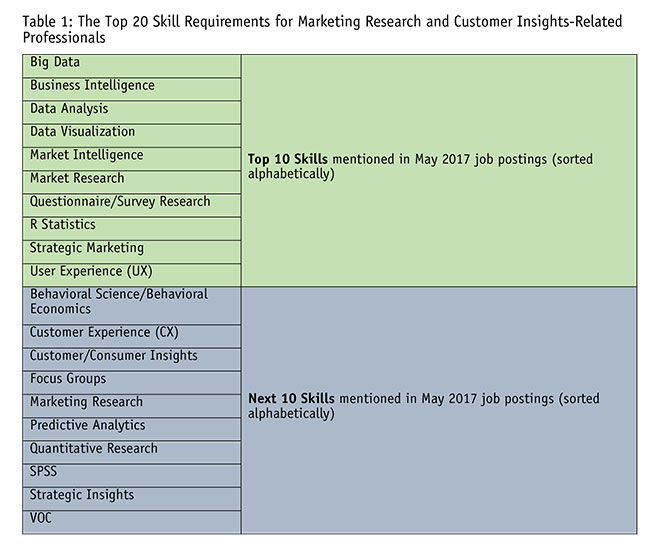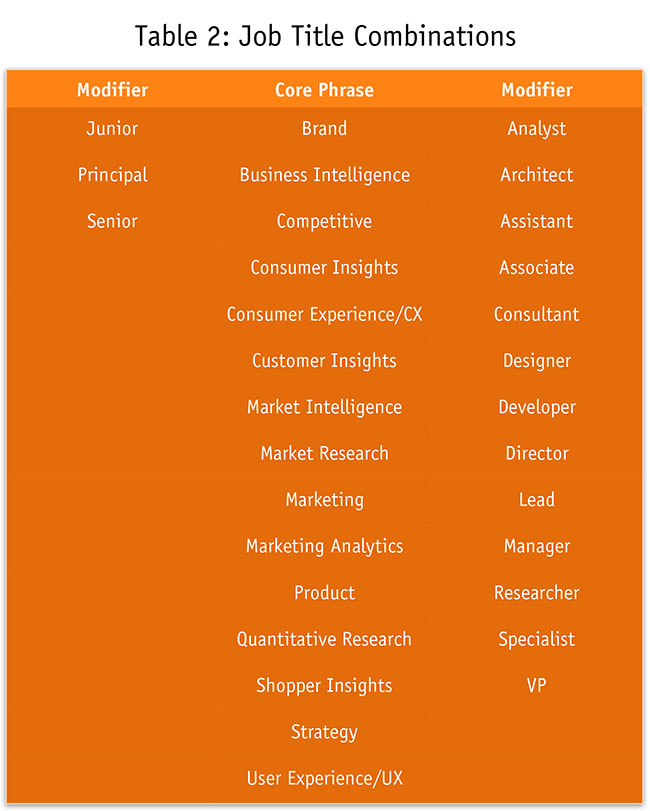Breaking the career bubble
Editor's note: Kathryn Korostoff is founder and lead instructor at Research Rockstar LLC, a Southborough, Mass., marketing research training and staffing services firm.
Career path options for marketing research and customer insights professionals have changed dramatically in the past three years and they are still evolving. If you haven’t taken a close look lately, your career-planning ideas may need a refresh. You may be making erroneous assumptions about skill or credential requirements. You may have outdated perceptions of job titles and volumes of openings – and of who else is competing for these same positions.
So, what is the state of career-planning for insights professionals, circa 2017? What are the most in-demand skills? What are the current job titles and in what relative volume do they exist? This article summarizes my research into these questions, drawing on analysis of over 30,000 job postings from Indeed.com and LinkedIn.
Skill set was standardized
If you’ve been in the insights profession for more than 10 years, you remember a time when the skill set – while certainly not trivial – was standardized around focus groups, in-depth interviews and surveys. If you had some solid quant or qual skills, you were qualified for many job openings. If you had both quant and qual credentials, you were golden.
In 2017, things are much more complex. Two major factors have driven this complexity.
The explosion in market research-related data tools, sources and methods and the corresponding increase in demand for people who have mastered them. Today, discovering and measuring customer attitudes and behaviors can be done using more than 20 major methods and literally over 100 tools. It is not possible to be an expert in everything anymore. The good news: There are a lot of opportunities for specialists, especially those who master new methods and tools. There’s still opportunity for generalists too but to pursue a generalist role in 2017 and beyond, the successful candidate needs to be methodology- and data source-agnostic. And in 2017, you can’t credibly claim to be a data-agnostic advisor if the only methods you recommend are focus groups, interviews and surveys. You will need to be able to advise when to use those methods and when to use options that leverage in-house data sources (customer databases, e-commerce databases, etc.).
The evaporation of traditional boundaries between various data-based corporate functions. Previously siloed, “marketing research,” “customer analytics,” “business intelligence,” “Web analytics,” “competitive analysis” and other groups are being reorganized or otherwise better integrated. This opens some new career path options, where you will likely be facing some new competition (colleagues who may know more about Python and Tableau and less about applications are a common example).

In Table 1 I list the top 20 skill requirements for marketing research and customer insights-related professionals (see sidebar for notes on methodology). In analyzing the top 20, some themes become apparent:
Intelligence is hot. There are many job openings requiring skills related to business or market intelligence. Indeed, the debate many people have had about “research” versus “insights” seems rather trivial when we consider the enormous employer demand for “intelligence.”
There are a lot of specialties. Thus, many skills did not make the top 20. Does that mean they are unimportant? No; just that skill requirements are very fragmented. For example, “secondary research” had fewer mentions than the items in the top 20 – but still had >400 job-posting mentions and thus is clearly a skill that will resonate with some employers. Same for “shopper insights” – an obviously important area of specialization. Related to the rise of specialties is the broad use of very precise skills across job postings. For example, “focus group” outpaced “qualitative research.” And “R” outpaced “predictive analytics” (for which R is commonly used).
Quant is hot. Many top skills are quantitative. There is no denying that this is the case. It appears that many qualitative methods are not as widely specified in job postings, although they can obviously apply. For example, a top 20 skill is “user experience” – which factually often does use qualitative research methods. Thus, a qualitative researcher may find more opportunities for career advancement by making a clear connection between their methodology expertise and how it applies to more commonly specified specialties such as “user experience.”
Even niche skills have many openings. A few skills that did not even make it close to the top 20 still had over 100 postings as of May 2017. Examples: ethnography/ethnographer – approximately 120 postings; category insights (often associated with, but different from, shopper insights) – approximately 130 postings; competitive intelligence – just over 100 postings.
As you consider the top 20 skills in Table 1, please note the following:
- Some skills mentioned in job postings read like job titles; the two obviously can overlap.
- Some skills overlap. I consolidated patently equivalent skills but those that I judged as different enough (based on frequency of separate mentions) are in the table even though there is obviously some overlap. For example, there are many openings that require “R or SPSS”; thus “R statistics” and “SPSS” sometimes overlap, but both are included in Table 1 because they also often exist separately.
- Some skills are very broad (“market research”), others are very precise (“R statistics”). That’s simply a reflection of how job postings are written.
- Because of month-to-month fluctuations and job posting overlaps (between LinkedIn and Indeed.com), it would be misleading to rank order the top skills from 1 to 20. Instead, I divide them into two categories: top 10 (sorted alphabetically) and next 10 (sorted alphabetically).
- • Some popular skills are rather generic and nearly universal, so including them in the table would diminish other items. Nearly universal skills excluded from the top 20: analysis (analytic thinking/analytical thinker/related variations); written and verbal communications; project management (and variations related to budget and schedule planning); presenting (and variations related to presentation skills, presenting to executive audiences and presenting for impact); and customer loyalty (which has the added problem of being used to mean at least two different things).
Don’t use ‘market research’ or ‘customer insights’
Defining the career category quickly led me to realize: There are many positions posted that specify requirements that are relevant, yet the job titles don’t use the phrases “market research” or “customer insights.” Two examples:
A job posting seeking candidates with expertise in “measuring brand perceptions” and “social media research” had the title Brand Manager. Thus “marketing researchers” seeking career advancement might consider brand manager as one of their options: it leverages existing skills and, with a bit of a logical skill extension, may be a viable path.
“Business intelligence” job postings often specify classic market research skills. Thus, for example, someone seeking a career path that specializes in using research to inform product development/product roadmap strategy may find their next great job is in business intelligence.
Consider the following description from a June 2017 job posting. What title do you think it may have had?
The [job title] will turn data into information, information into insight and insight into business decisions. This role will conduct full lifecycle activities to include requirements analysis and design, develop analysis and reporting capabilities. The [job title] will discover and curate new and existing data sources to create solutions for the business. This is a key position which helps bring data to life. The [job title] will be responsible for querying and analyzing large sets of structured and unstructured data and developing solutions from this data, including ad hoc analysis.
The title? Data Analyst. Just that.
Try this one. What do you think the job title is?
Under minimal supervision, plans and conducts user research activities (e.g., usability testing, online surveys, interviews, contextual inquiry and focus groups) and translates findings into actionable customer insights that inform product development and optimization. This includes active involvement in the entire product development process, including identifying customer needs, ideation, testing and ongoing optimization.
Can you guess? User Experience Researcher.
And lastly:
Provides support through research, customer insights and analysis of the company’s markets, competition, customers and end users. Analyzes the competitive environment, customer insights, future trends, product usage and makes recommendations based on findings. Provides updates to inform product/solution design, marketing and business strategy.
Any guesses? Senior Advisor, Market Intelligence.
There are many job openings – and hot career paths – that leverage marketing research skills but they have new (and diverse) job titles. The core phrases in Table 2 represent the top 15 phrases. The challenge is that they are modified in very diverse ways. There are openings for Junior Brand Analyst and for Brand Managers that have job requirements that intersect heavily with those of many marketing research and consumer insights professionals. Consider it a slot-machine approach to job titles: Pull the lever and see what comes up! (Note: The items are sorted alphabetically, not by volume of job postings.)

Take a fresh look
Anyone who cares about advancing their career (or the career of someone else) in this space needs to take a fresh look: What are the current career path options? What are the skill requirements?
Based on this research, I see some great news: There are many opportunities out there. Still, to successfully pursue many of them, you need to be clear about which ones you want – you may need to (perhaps just lightly) update your skills, credentials and network to get there.
Some final thoughts:
You can’t do it all. You will have to make a choice: Do you want to be a generalist or a specialist? Which would you rather be? Or do you foresee an evolution – perhaps starting in one role and evolving to another?
Don’t get hung up on language – especially “research” versus “insights” versus “intelligence” – when looking for job postings. Titles can be very misleading. Searching for skills may be a better way to find openings that align with your credentials and interests.
Understand that traditional boundaries are blurring, especially those between market research, business intelligence and customer analytics. You next great job opportunity may be in a new department or at least a differently-integrated one.
Be ready to brag. As a professional researcher, you have awesome skills that are needed in the new blended world of all things data. For example, did you know there is widespread angst about the lack of ROI for many big data projects? And that it is often attributed to lack of clarity around project goals? That is a classic client management skill – and one many professional marketing research and customer insights professionals have mastered.
I hope this research helps you to refresh your career assumptions.
Methodology notes
- Job postings from both Indeed.com and LinkedIn were used. Because of month-to-month fluctuations and observations about job-posting overlap, I’m reporting relative volume, not absolute numbers.
- After considering data source options, I decided to focus on current job postings: thus, the research shared in this article is based on analysis of over 30,000 job postings.
- To avoid being biased by specific job titles, I searched using phrases such as “research,” “insights” and “analysis” related to: broad categories such as “market research,” “customer insights,” “customer/consumer attitudes,” “customer/consumer behavior” and similar; discovering, measuring, predicting or experimenting with customer attitudes or behaviors; and application categories to capture job postings related to common research applications such as brand loyalty, pricing research, product concept testing, segmentation, etc.
- Data was gathered in May 2017. I had previously gathered higher-level counts but the May 2017 effort was the first in-depth data collection. I plan to do another round at a six-month interval.
- If anyone is interested in collaborating on this research, please get in touch.
